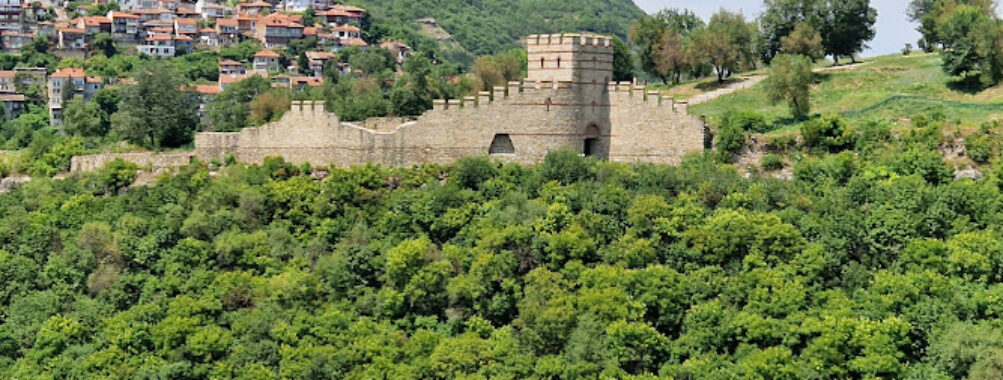
Trapezitsa Fortress
Table of Contents
About Trapezitsa Fortress
Trapezitsa Fortress stands as a sentinel on a namesake hill in Veliko Tarnovo, the heart of medieval Bulgaria. Veliko Tarnovo, once the flourishing capital of the Second Bulgarian Empire, is marked by the Yantra River’s winding course. The fortress itself, a witness to Bulgaria’s robust past, is perched high on the hill, its walls skirting 81 meters above the river, creating steep cliffs that historically shielded the stronghold.
This medieval citadel is a testament to the Bulgarian prowess in fortification, where the confluence of the Thracian, Roman, and medieval Bulgarian cultural layers converge. Key features of Trapezitsa include its strong fortress walls and its gate, which once admitted royals and commoners alike. Inside the fortification, remains of several churches speak of a monastic community rich with frescoes and murals echoing the spiritual life of the Middle Ages.
The historical significance of Trapezitsa in relation to Tsarevets, another eminent fortress in Tarnovo, is profound. Both citadels played pivotal roles during the Second Bulgarian Empire, with Trapezitsa being the second most important citadel of the capital, Tarnovo.
Efforts of restoration allow visitors to witness the museum incorporating sites of ancient mosaics, and monastic relics now immortalized through preservation. Restoration work reaffirms the site’s place in Bulgarian history and the larger narrative of European fortresses. The hilltop not only offers a historical journey through its museum and exposed layers of history but also grants panoramic views of Veliko Tarnovo, a sight that has watched over the rise and fall of empires.
Best Time to Visit
When planning a trip to Veliko Tarnovo’s Trapezitsa Fortress, timing is essential for an enriching experience. Summer months are typically warm and ideal for exploring, offering clear skies that bode well for appreciating the fortress and the panoramic views of the surroundings. However, visitors should bear in mind that this period can also bring crowds and higher temperatures.
For a more comfortable visit with moderate weather, late spring and early autumn are excellent choices. These seasons strike a balance between pleasant climate and thinner crowds, allowing for a leisurely exploration of both Trapezitsa and the nearby Tsarevets Fortress. The occasional rain shower can occur, so carrying an umbrella is advisable.
To enhance their visit, travelers can utilize the funicular to reach the fortress, available during the peak visiting hours. This option provides a unique vantage point and spares the legwork of climbing up the hill. The funicular service operates more frequently in the high season, coinciding with the increased visitor numbers.
Here’s a quick guide to help plan the visit:
- Summer (June to August): Ideal for uninterrupted views; prepare for heat and crowds.
- Spring (April to May): Cooler temperatures; a mix of sunny and rainy days.
- Autumn (September to October): Crisp air and fewer tourists; occasional rain.
When visiting, always check the local weather forecast and be prepared for the day’s conditions. Despite being open to the elements, the fortress stands as a testament to history, welcoming those who seek to uncover its past, regardless of the season.
Nearby Attractions
While the historical Trapezitsa Fortress itself is a beacon of the past, the surrounding area is sprinkled with a myriad of attractions that offer visitors a deeper understanding of Veliko Tarnovo’s rich history.
Tsarevets Hill is perhaps the most iconic of these attractions, with its impressive Tsarevets Fortress. The site once served as the main fortress of capital Tarnovgrad during the Second Bulgarian Kingdom. Today, both locales are a testament to Bulgaria’s medieval magnificence, boasting royal palaces, fortified walls, and remnants of churches. The dramatic Sound & Light Show at Tsarevets Hill animates the fortress’s storied past through a harmonious blend of music, lights, and church bells.
Below the hills, the Holy Forty Martyrs Church with its remarkable architecture including pilasters, niches, and blind arches, invites exploration. This sanctuary is an essential site for understanding the religious significance and the role it played in the coronation of Bulgarian tsars.
Samovodska Charshiya, the old market street, immerses visitors in the artisan spirit with its restored workshops and houses from the Revival period. It’s a perfect spot to witness traditional crafts and purchase unique Bulgarian artifacts.
Archaeology enthusiasts mustn’t miss the Archaeological Museum, housing a priceless collection from various ages, ranging from the Thracian settlements to the Medieval Bulgarian Empire. Artifacts excavated from Trapezitsa are often showcased here, providing insight into the lives of aristocracy and soldiers who once roamed the fortress.
For those seeking a panoramic glimpse of the city, a climb to the Execution Rock is well worth the effort. This precipice on the edge of Trapezitsa offers a viewpoint not only of the ruins below but also of the landscape where Thracians, Romans, Byzantines, and Slavs once thrived.
Location
Places to Stay Near Trapezitsa Fortress
Find and Book a Tour
Explore More Travel Guides
No reviews found! Be the first to review!